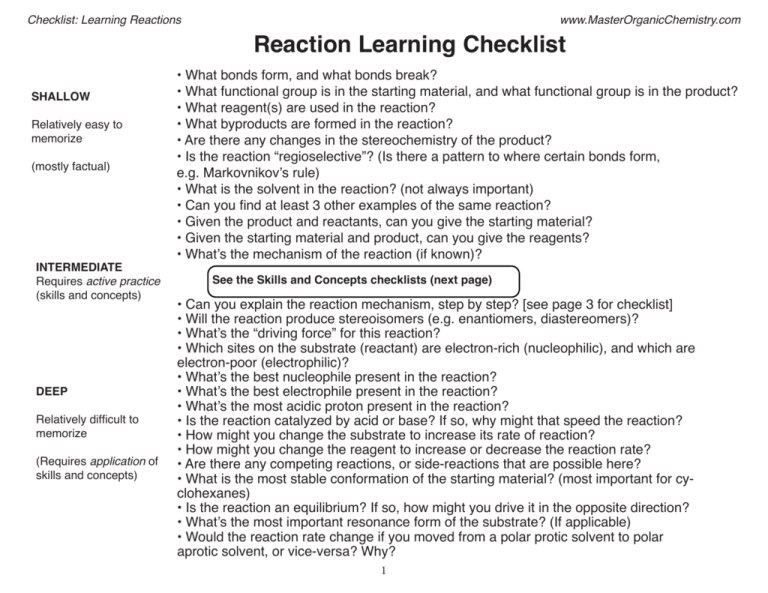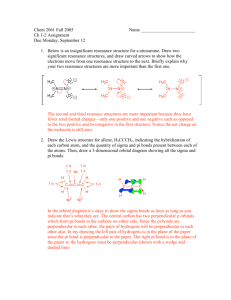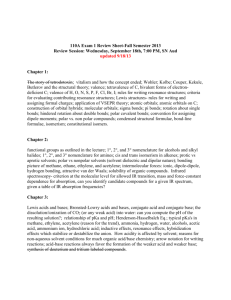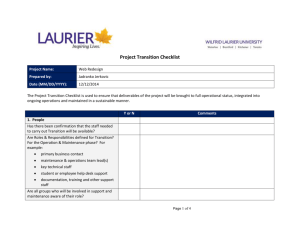Reaction Learning Checklist
advertisement

Checklist: Learning Reactions SHALLOW Relatively easy to memorize (mostly factual) INTERMEDIATE Requires active practice (skills and concepts) DEEP Relatively difficult to memorize (Requires application of skills and concepts) www.MasterOrganicChemistry.com Reaction Learning Checklist • What bonds form, and what bonds break? • What functional group is in the starting material, and what functional group is in the product? • What reagent(s) are used in the reaction? • What byproducts are formed in the reaction? • Are there any changes in the stereochemistry of the product? • Is the reaction “regioselective”? (Is there a pattern to where certain bonds form, e.g. Markovnikov’s rule) • What is the solvent in the reaction? (not always important) • Can you find at least 3 other examples of the same reaction? • Given the product and reactants, can you give the starting material? • Given the starting material and product, can you give the reagents? • What’s the mechanism of the reaction (if known)? See the Skills and Concepts checklists (next page) • Can you explain the reaction mechanism, step by step? [see page 3 for checklist] • Will the reaction produce stereoisomers (e.g. enantiomers, diastereomers)? • What’s the “driving force” for this reaction? • Which sites on the substrate (reactant) are electron-rich (nucleophilic), and which are electron-poor (electrophilic)? • What’s the best nucleophile present in the reaction? • What’s the best electrophile present in the reaction? • What’s the most acidic proton present in the reaction? • Is the reaction catalyzed by acid or base? If so, why might that speed the reaction? • How might you change the substrate to increase its rate of reaction? • How might you change the reagent to increase or decrease the reaction rate? • Are there any competing reactions, or side-reactions that are possible here? • What is the most stable conformation of the starting material? (most important for cyclohexanes) • Is the reaction an equilibrium? If so, how might you drive it in the opposite direction? • What’s the most important resonance form of the substrate? (If applicable) • Would the reaction rate change if you moved from a polar protic solvent to polar aprotic solvent, or vice-versa? Why? 1 Checklist: Learning Reactions www.MasterOrganicChemistry.com Reactions: Skills and Concepts Some Important Skills Required To Learn Reactions note - many of these bullet points link to (hopefully) helpful external web pages • see “hidden” hydrogens and lone pairs in line drawings of molecules • recognize an atom’s hybridization (sp, sp2, sp3) • calculate formal charge of an atom • recognize electron rich and poor areas of molecules (dipoles) by applying relative electronegativities • interpret and draw curved arows to show electron flow, and bonds forming/breaking • draw resonance structures of a molecule, and convert them using curved arrows • identify the most important resonance forms of a molecule • given pKa values, be able to predict which direction an acid-base reaction will proceed • given an acid, draw the conjugate base • given a base, draw the conjugate acid • recognize primary, secondary, tertiary alcohols and alkyl halides • interpret and draw rings and cyclohexanes (especially the cyclohexane chair conformation) • recognize whether molecules are enantiomers, diastereomers, or the same Some Important Concepts Required To Understand Reactions • Why do atoms adopt different geometries (tetrahedral, trigonal planar, linear...) • What factors influence the stability of different conformations (alkyl chains and cyclohexane rings) • What factors affect the relative importance of different resonance forms? • What factors influence the stability of rings? (hint: angle strain, torsional strain) • What factors influence acidity and basicity? • What factors influence nucleophilicity? • What makes something a “good” leaving group? • What factors influence the stability of carbocations and free radicals ? • Under what conditions do carbocation rearangements occur? • What is steric hindrance, and under what conditions can it affect reactivity? 2 Checklist: Learning Reactions www.MasterOrganicChemistry.com Learning A Mechanism: Deeper Questions • What bonds form and what bonds break in each curved arrow of the mechanism? • Can the sequence of curved arrows be broken down into discrete “steps” ? Do these “steps” have names? • What bonds form and break in each “step” of the mechanism (this is slightly different from the first question!) • For each step: can you identify a nucleophile and an electrophile? (usually, but not always possible) • What’s the slowest step of the mechanism? • How does the mechanism explain the reason for why the reaction has a given stereochemistry (e.g. syn, anti) [if applicable] • How does the mechanism explain the reason for why the reaction has a given regiochemistry (e.g. Markovnikov’s rule, Zaitsev’s rule) [if applicable] Bonus Questions After Learning A Reaction • Can you come up with an “intramolecular” version of this reaction? • Of the individual “steps” - can you find other reaction mechanisms that share these key steps? It can be very helpful to group these reactions together into families - many patterns repeat! • Try to come up with 3 reactions that involve the product of the reaction. E.g. if the reaction forms an alkene... can you come up with 3 reactions where this alkene could be a starting material? • Try to come up with at least 3 reactions where the reactant in the reaction would be a product of a different reaction. For example, if your reaction starts with an alkyl halide... can you find 3 reactions where this alkyl halide would be a product? 3





